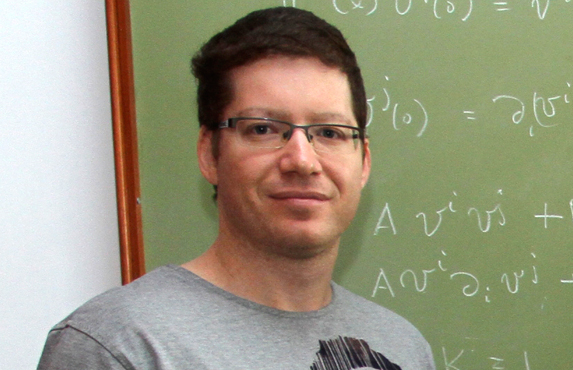
Dr. Komargodski is one of three promising young theoretical physicists to be awarded the New Horizons in Physics Prize.
The 2013 New Horizons in Physics Prize, awarded by the Fundamental Physics Prize Foundation, has been given to three promising young researchers, including the Weizmann Institute’s Dr. Zohar Komargodski. Each of the laureates will receive $100,000. The Foundation also announced that leaders of the ATLAS experiment, one of the two experimental groups at the Large Hadron Collider (LHC) at CERN to have discovered a particle that appears to be the Higgs boson, will split a Special Fundamental Physics Prize (which totals $3,000,000) with those of the second experimental group, CMS, together with the head of the LHC accelerator project. Several Weizmann Institute researchers have played prominent roles in the ATLAS experiment, along with physicists from the Technion and Tel Aviv University. Last year, one of the inaugural Fundamental Physics Prizes went to Prof. Nathan (Nati) Seiberg, a Weizmann alumnus who is at the Institute for Advanced Studies, Princeton.
Dr. Komargodski completed his doctoral studies in physics at the Weizmann Institute of Science four years ago. Following a postdoctoral fellowship at the Institute for Advanced Studies, Princeton, he returned to a senior scientist position in Weizmann’s Department of Particle Physics and Astrophysics. His research involves quantum theory, and sheds new light on a number of related fields. One of his outstanding achievements was an article he published with the Institute’s Prof. Adam Schwimmer in 2011. This paper provided proof for a basic conjecture concerning theories of quantum fields (theories that describe the behavior of elementary particles) in four-dimensional space-time.
This conjecture was first proposed by the British physicist John Cardy in 1988. According to Cardy’s theorem, inequalities arise in systems with known “rules” that involve large numbers of factors. The states of these systems cannot be explained just through knowing the rules and the various players. Examples of such systems include stock markets, traffic patterns, and weather. The inequalities transpire between degrees of freedom: those existing at short-distance scales (for example, the scales of the new particles that LHC researchers hope to discover) versus those at longer-distance scales (for instance, in the forms of matter we know today).
If Cardy’s theory proves correct, it might provide an explanation of how we arrive at the Standard Model — the main theory of particle physics in use today — when a system of infinitesimally small particles at small-distance scales and very high energies cools down. We might even begin to understand how the world as we know it arises out of a complex universe of subatomic particles and powerful forces.
Meeting on the beach
In 1986, about two years before Cardy presented his theory, another physicist, Alexander Zamolodchikov, had shown that this inequality between degrees of freedom on short-distance scales exists in two-dimensional systems (one dimension of space and one of time). Cardy took the idea one step further, theorizing a similar inequality in a four-dimensional system (three of space and one of time). But the theory remained open for the next 23 years, until one evening when Dr. Komargodski and Prof. Schwimmer, who were attending a conference together, were relaxing on a beach on an Aegean island. For the last few years, Prof. Schwimmer and Dr. Komargodski had been looking for a way to prove Cardy’s theorem and turn it into an accepted axiom. They had traded ideas and explored a number of different avenues, but none had really panned out. But that evening, sitting on the Aegean sands and relaxing between lectures, the two began to discuss their old problem. As the sun set over the blue water, the solution seem to float up to them: although none of the methods they had applied to the problem had yielded the long-awaited proof, they realized that four or five of their beginnings might be combined into a framework on which they could erect that proof.
Dr. Zohar Komargodski’s research is supported by the Peter and Patricia Gruber Awards.
For more on the prizes: http://www.fundamentalphysicsprize.org/
